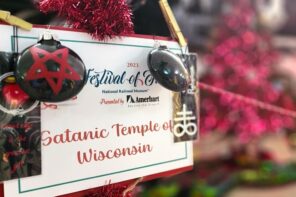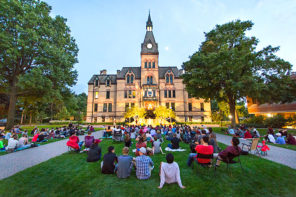New York City’s Landmark Preservation Commission’s unanimous decision on August 3, 2010, to allow plans for the construction of a mosque and community center near Ground Zero to move forward has been hailed by some as a victory for religious freedom, but it has also provided more fodder for latent anti-Muslim sentiments that have surfaced nationally since plans for the project were made public. Regardless of how one views the decision, the controversy surrounding the project is a reminder of the fact that while religious pluralism was a founding ideal of the United States implicit in the First Amendment’s guarantee of religious freedom, Americans historically have edged toward it kicking and screaming.
In the 19th century, it was Roman Catholicism that represented the most prominent threat to what were believed to be sacred American values. Detractors called it “Romanism” or the “popeish” religion, and the claims made against it were that it did not recognize secular authority, promoted intolerance and violence, and demanded blind obedience to its ancient doctrines. These are all charges currently made against Islam as a religion.
In the late 19th century, the prominent nativist Josiah Strong wrote, “It has been shown that it is the avowed purpose of Romanists to ‘make America Catholic.’ It has been shown that this could not be done without bringing into active conflict the diametrically opposed principles of Romanism and the Republic, thus forcing all Romanists in the United States to choose between two masters, both of whom they now confess to serve.”
I suspect it would be with a great sense of irony that Strong would view today’s Catholic American leaders, such as Rick Lazio, Carl Paladino, and Newt Gingrich on the political stage assessing the threat that members of another religious tradition pose to Americans and their values.
How did the tide of perception change for Catholic Americans? Their assimilation was successful largely because of the establishment of religious institutions through which they could participate in and adapt to their local American communities. A major impetus for the rise of Catholic schools in this country was anti-Catholicism. Catholic schools and organizations such as the Knights of Columbus, like Jewish organizations and Community Centers, became safe havens through which distinctly American Catholic and American Jewish communities and identities were formed.
In recent years, an American Muslim identity is also emerging from the long history of Muslim community building in the United States. This story dates back to the European discovery of the Americas. We often forget that Europeans crossed the Atlantic in search of trade routes that would bypass Muslim empires and merchants. People of Muslim heritage were involved in the encounters and rivalries that established the Atlantic world, and some of them ended up in the Americas.
It was not, however, until the rise of the Atlantic slave trade that tens of thousands of Muslims were brought to America. They participated in local slave communities and even entered into relations with whites. For many, Islam played an important role in these relationships. Some African Muslims living on Georgia plantations reinforced their communal relations by making rice cakes and distributing them as alms (sadaqa or saraka) among the local children. Others formed relations with their masters through religion. ‘Umar ibn Said, who left us with a precious autobiography in Arabic, distinguished himself from his master religiously. Yet, he had a prayer which opened with “God, our Lord, our Creator… open my heart to the Gospels, to the path of guidance,” and closed with a Qur’anic phrase, “Praise belongs to God, the Lord of the Worlds.”
The first American Muslim institution was founded on East 23rd Street in lower Manhattan in 1892 by Mohammed Alexander Russell Webb, an American diplomat and Theosophist who converted to Islam and was funded by Indian merchants to proselytize in the United States.
Webb’s efforts failed, but he was followed by thousands of immigrants from the Middle East, Eastern Europe, and South Asia and by African Americans, who converted to varying forms of Islam, some of which, such as the Nation of Islam, were distinctly a product of African American experiences. They built American mosques and Muslim institutions in such diverse places as Brooklyn, Detroit, Chicago, Pittsburgh, Cleveland, Ross, North Dakota, and Cedar Rapids, Iowa. The mosque built in Cedar Rapids in 1934 is the oldest American Muslim institution and is on the national register of historic places. American Muslims refer to it fondly as the Mother Mosque.
American Muslims’ community building efforts between the World Wars were so successful in shaping a specifically American Islamic identity that when American Muslims who had fought in World War II returned home they sought to gain national recognition for Islam. They held a convention of some 400 Muslims in 1952 in Cedar Rapids in order to start an umbrella organization that came to be called the Federation of Islamic Associations of the United States and Canada (FIA). The first president of the FIA, Abdallah Igram, a World War II veteran, approached President Eisenhower in 1953 to ask, “Why is there no symbol for the Islamic faith on a Muslim serviceman’s identification tags so that he might be given fitting burial rites if he’s killed in action?” His query led to the use of an “I” on the dog tags of American Muslim soldiers.
In the 1950s and 1960s, as immigration laws were liberalized and as Malcolm X and the Nation of Islam came to play a national role in the civil rights struggles of the period, the number of Muslim immigrants and converts increased. Many of these Muslims were politicized by anti-colonial movements abroad as well as civil rights struggles at home. Much of their activism took the form of Muslim community and institutions building. Although in the beginning they required support from Muslim organizations abroad, they became, in time, more and more independent as well as more engaged in local civic and political activities. The Council of American-Islamic Relations (established in 1994) is but one example of such institutions. It was founded with the aim of fighting for causes of concern to Muslims abroad (such as the Palestinian-Israeli conflict), but, as the needs and concerns of American Muslims changed, it evolved into an advocacy organization for American Muslim civil rights.
The local and national Muslim institutions built throughout the twentieth century provided a way for Muslims to participate in American society as both Americans and Muslims despite the stigmatizing discourses they faced related to both Islam in the United States and America in the Muslim-majority world.
While Newt Gingrich and other opponents of the planned mosque and community center in lower Manhattan try to convince Americans that the so-called Ground Zero Mosque is “all about conquest” and “Islamist triumphalism which we should not tolerate,” the history of Islam in America tells a different story. It suggests that the proposed mosque and community center, which is modeled after the New York YMCA and Jewish Community Center, is a continuation of century-old efforts at community building and an attempt to represent Islam in lower Manhattan as American Muslims have understood and experienced it rather than through the actions of terrorists. The decision to allow the building of the mosques and community center is yet another episode in American history that moves us closer to the realization of our nation’s founding ideal of religious pluralism and freedom amidst a din of protests.




